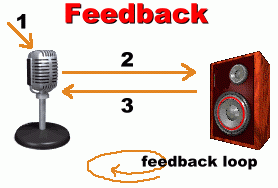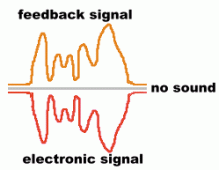|
No street fair would be complete without live music. This group was very good, and collected quite an audience. Their instruments weren't electric, for the most part, but they used microphones, an amplifier, and speakers in order to make their music loud. Notice the speakers at positions 1 and 2. By placing the speakers ahead of the microphones like this, and pointing at the audience, they are helping to avoid electronic feedback, a common symptom of amplified microphones. Let's look at what feedback really is ...  Feedback happens when sound enters a microphone (1) and gets amplified. This boosted sound then gets sent to the speakers (2), where it is supposed to be sent on to the audience.
Feedback happens when sound enters a microphone (1) and gets amplified. This boosted sound then gets sent to the speakers (2), where it is supposed to be sent on to the audience.What usually happens, though, is that some of this amplified sound (3) finds its way back to the microphones, to get amplified again. This produces an additional signal to be sent out to the speakers, and some of this will get back to the microphone, to get amplified a third time. Eventually part of the sound is being amplified over and over, and getting louder and louder. Sound is constantly returning to the microphone and being sent back out. This is called a feedback loop. Part of the original sound or music is going in circles, and getting amplified over and over. This produces a high-pitched squeal from the speakers, which is very annoying. How do you eliminate feedback? Well, the simple answer is that you can't ... sound travels in all directions, and some of it will always get back to the microphone, even if the speakers are in front of the mike and pointing away from it. However, the amount of feedback can be lessened, and its effects can be minimized or eliminated. This is done in several ways. The speakers can be designed to project sound outwards, so that very little will get back to the microphone. The microphone will be highly directional, so that very little of the sound from the speaker that does make it to the mike will be picked up and amplified. And the most ingenious solution of all is to use a feedback eliminator ... an electronic device that emits its own sound ... sound that is designed to 'cancel' the feedback sound.  Look at the diagram on the right.
Look at the diagram on the right.The orange wave represents the feedback noise, that would sound like a high-pitched screech. The electronic feedback eliminator analyzes this signal, and sends out a wave that's exactly the inverse ... the red wave. These two waves leave the speaker together, and cancel each other out, producing no sound (the grey line). Since many different sounds can produce feedback, there may be many different feedback signals ... but the feedback eliminator produces signals to cancel them all. |